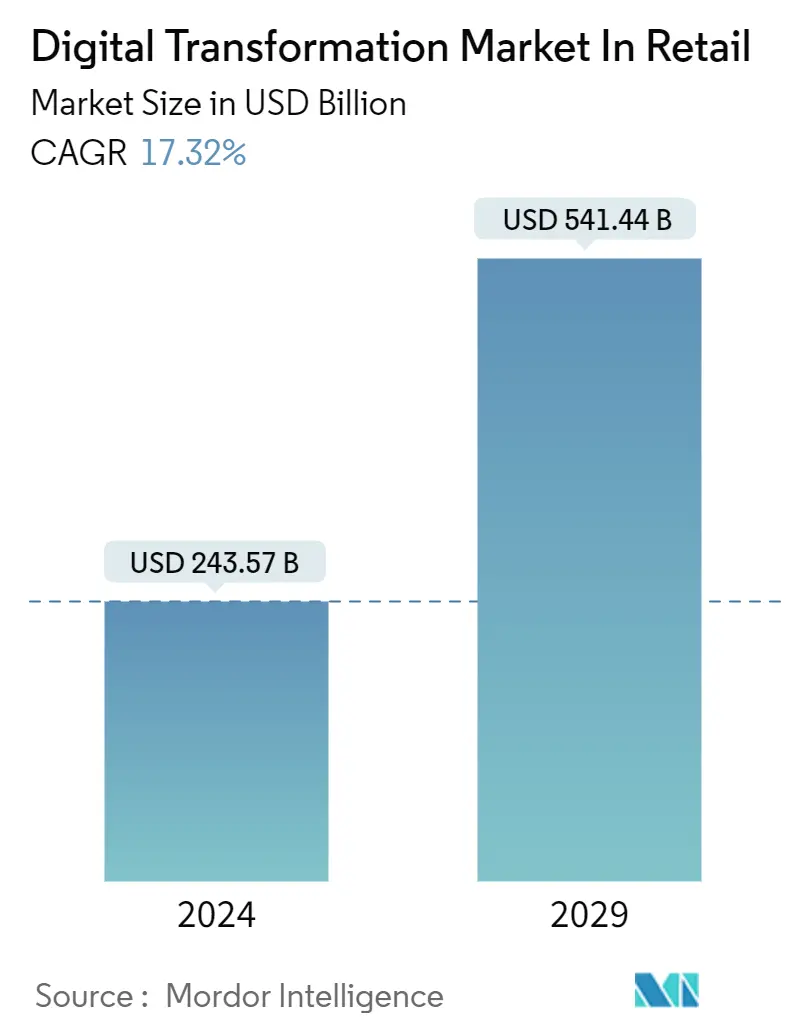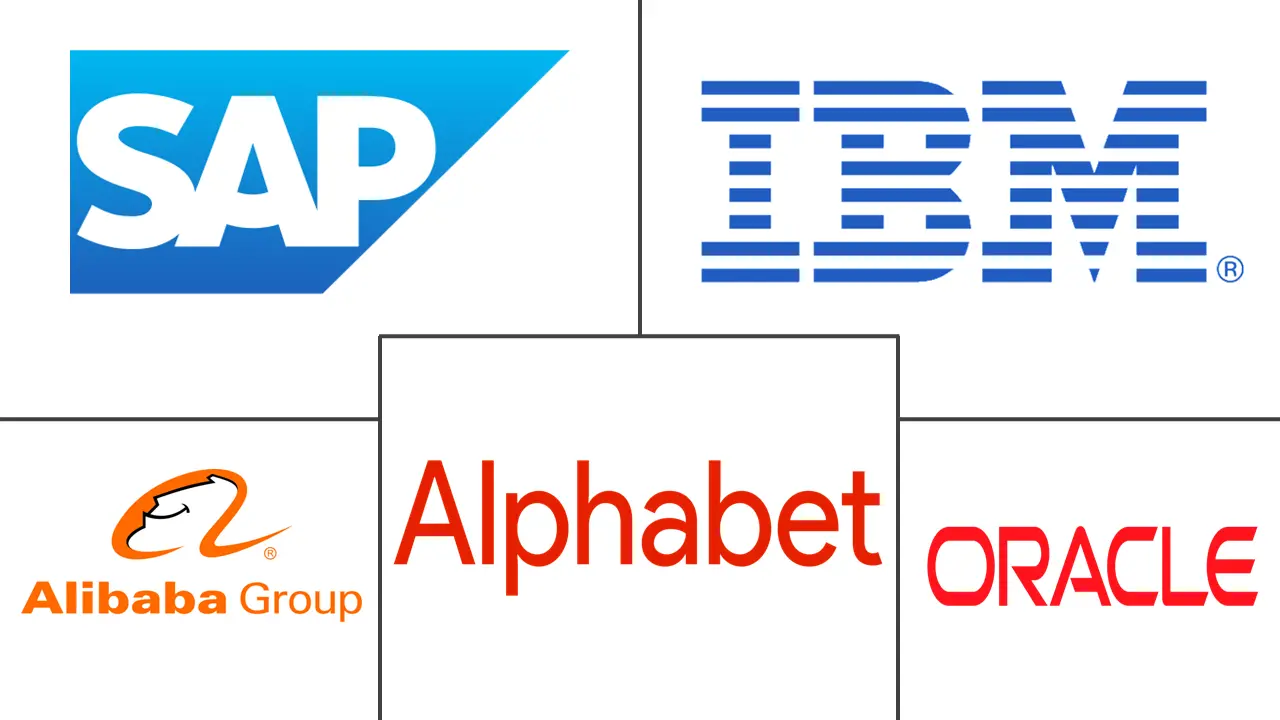Market Size of Digital Transformation Industry In Retail

| Study Period | 2019 - 2029 |
| Market Size (2024) | USD 243.57 Billion |
| Market Size (2029) | USD 541.44 Billion |
| CAGR (2024 - 2029) | 17.32 % |
| Fastest Growing Market | Asia Pacific |
| Largest Market | North America |
| Market Concentration | Medium |
Major Players
*Disclaimer: Major Players sorted in no particular order |
Retail Industry Digital Transformation Market Analysis
The Digital Transformation Market In Retail Industry is expected to grow from USD 243.57 billion in 2024 to USD 541.44 billion by 2029, at a CAGR of 17.32% during the forecast period (2024-2029).
- The advent of digital technologies for collecting, storing, analyzing, and distributing information has created new dynamics in the digital transformation of the retail market. These digital technologies also raised numerous new opportunities for vendors serving the market as an organization requires an efficient and easy work process owing to the increase in worldwide liberal trade policies and end-users.
- Rapidly increasing internet penetration is a key factor contributing to the market's growth over the forecast period. An increase in smart gadgets and incremental technological advancements will pave the way for growth in this market by making this technology more accessible to small/medium-scale retail organizations. For instance, according to ITU 2022 report, internet users globally increased from 3,217 million in 2016 to 4,901 million in 2021.
- Customers' rising demands are pushing merchants to form strategic alliances with technology suppliers in order to capitalize on new prospects. These collaborations enable merchants to improve their technological competence and offer value to their operations. Retailers are progressively cooperating with tech suppliers to develop the most appropriate and long-term business solutions, which have contributed to market growth.
- For instance, recently, Macy's, Inc. revealed intentions to develop a curated online marketplace in order to expand the company's current influence as a digitally driven omnichannel retailer. By allowing carefully chosen third-party retailers to offer their items on macys.com and bloomingdales.com, the expanded marketplace will dramatically increase the company's inventory in established areas and brands while also introducing a variety of new regions.
- The outbreak of COVID-19 had a favorable influence on industry development throughout and after the outbreak. The demand to improve operational productivity is significantly fuelling the development of the digital transformation industry. Furthermore, the pandemic has boosted the growth of the retail e-commerce industry as consumers tend to purchase more retail products from e-commerce websites to prevent them from getting infected.
- Numerous shops focus on incorporating modern technology, including big data and AI, to help their company develop. Furthermore, a significant challenge they encounter is a need for more in-house competencies and knowledge. Employing IT expertise is challenging since leading technology businesses are competing for the finest people. These factors are expected to create obstacles to market growth over the coming years.
Retail Industry Digital Transformation Industry Segmentation
Digital Transformation is a movement from point solutions that deliver incremental value to integrated process and technology solutions that provide transformational outcomes in terms of Business Efficiency, Customer Experience, and/or Business Innovation. The Digital Transformation Market in Retail is segmented by Accessibility (Mobile Application, Website), Products (Consumer Electronics, Media and Entertainment, Apparel), Technology (Cloud computing, Big data, AI, IoT, AR/VR), and Geography (North America, Europe, Asia Pacific, Latin America, Middle East & Africa). The market sizes and forecasts are provided in terms of value (USD million) for all the above segments.
| By Accesibility | |
| Mobile Application | |
| Website |
| By Product | |
| Consumer Electronics | |
| Media and Entertainment | |
| Apparel | |
| Food and Beverage | |
| Furniture and Home Decor | |
| Beauty and Personal Care | |
| Other Products |
| By Technology | |
| Cloud computing | |
| Big data | |
| AI | |
| IoT | |
| AR/VR |
| Geography | ||||||
| ||||||
| ||||||
| ||||||
| ||||||
|
Digital Transformation Market In Retail Size Summary
The retail digital transformation market is experiencing significant growth, driven by the integration of advanced digital technologies that enhance the efficiency and effectiveness of retail operations. The increasing penetration of the internet and the proliferation of smart devices are key factors propelling this market forward, making digital solutions more accessible to small and medium-sized enterprises. Retailers are increasingly forming strategic partnerships with technology providers to enhance their technological capabilities and meet the evolving demands of consumers. This trend is evident in initiatives like Macy's expansion of its online marketplace, which aims to strengthen its position as a digitally driven omnichannel retailer. The COVID-19 pandemic has further accelerated this transformation, as the shift towards e-commerce has intensified, prompting retailers to adopt digital technologies to improve operational productivity and cater to changing consumer preferences.
North America is poised to capture a significant share of the retail digital transformation market, fueled by the rapid growth of e-commerce and the expansion of small and medium-sized enterprises. The region's robust infrastructure and high internet penetration rates support the increasing trend of online shopping, which offers consumers convenience and competitive pricing. Major retailers in North America are investing in digital transformation to provide personalized shopping experiences and maintain a competitive edge. The market is moderately competitive, with numerous players like SAP SE, IBM Corporation, and Alibaba Group Holding Ltd. continuously innovating to attract a larger customer base. Recent developments, such as Globant's Retail Studio and Inmar Intelligence's promotional tools, highlight the ongoing efforts to enhance digital engagement and streamline retail operations. These advancements, along with strategic initiatives by companies like Boots and Primark, underscore the critical role of digital transformation in shaping the future of the retail industry.
Digital Transformation Market In Retail Market Size - Table of Contents
-
1. MARKET DYNAMICS
-
1.1 Market Overview
-
1.2 Market Drivers
-
1.2.1 Increased Usage of Smart Devices
-
1.2.2 Growing Need for Advanced Mobile Logistics Management
-
1.2.3 Demand for Increase in the Yield and Efficiency
-
-
1.3 Market Restraints
-
1.3.1 Lack of General Awareness and Expertise in Emerging Regions
-
1.3.2 Standardization and Integration Issues
-
-
1.4 Industry Attractiveness - Porter's Five Forces Analysis
-
1.4.1 Threat of New Entrants
-
1.4.2 Bargaining Power of Buyers
-
1.4.3 Bargaining Power of Suppliers
-
1.4.4 Threat of Substitute Products
-
1.4.5 Intensity of Competitive Rivalry
-
-
-
2. MARKET SEGMENTATION
-
2.1 By Accesibility
-
2.1.1 Mobile Application
-
2.1.2 Website
-
-
2.2 By Product
-
2.2.1 Consumer Electronics
-
2.2.2 Media and Entertainment
-
2.2.3 Apparel
-
2.2.4 Food and Beverage
-
2.2.5 Furniture and Home Decor
-
2.2.6 Beauty and Personal Care
-
2.2.7 Other Products
-
-
2.3 By Technology
-
2.3.1 Cloud computing
-
2.3.2 Big data
-
2.3.3 AI
-
2.3.4 IoT
-
2.3.5 AR/VR
-
-
2.4 Geography
-
2.4.1 North America
-
2.4.1.1 United States
-
2.4.1.2 Canada
-
-
2.4.2 Europe
-
2.4.2.1 United Kingdom
-
2.4.2.2 France
-
2.4.2.3 Germany
-
2.4.2.4 Rest of Europe
-
-
2.4.3 Asia Pacific
-
2.4.3.1 China
-
2.4.3.2 Japan
-
2.4.3.3 India
-
2.4.3.4 Rest of Asia-Pacific
-
-
2.4.4 Latin America
-
2.4.4.1 Mexico
-
2.4.4.2 Brazil
-
2.4.4.3 Argentina
-
2.4.4.4 Rest of Latin America
-
-
2.4.5 Middle East & Africa
-
2.4.5.1 United Arab Emirates
-
2.4.5.2 Saudi Arabia
-
2.4.5.3 Rest of Middle East & Africa
-
-
-
Digital Transformation Market In Retail Market Size FAQs
How big is the Retail Digital Transformation Market?
The Retail Digital Transformation Market size is expected to reach USD 243.57 billion in 2024 and grow at a CAGR of 17.32% to reach USD 541.44 billion by 2029.
What is the current Retail Digital Transformation Market size?
In 2024, the Retail Digital Transformation Market size is expected to reach USD 243.57 billion.

